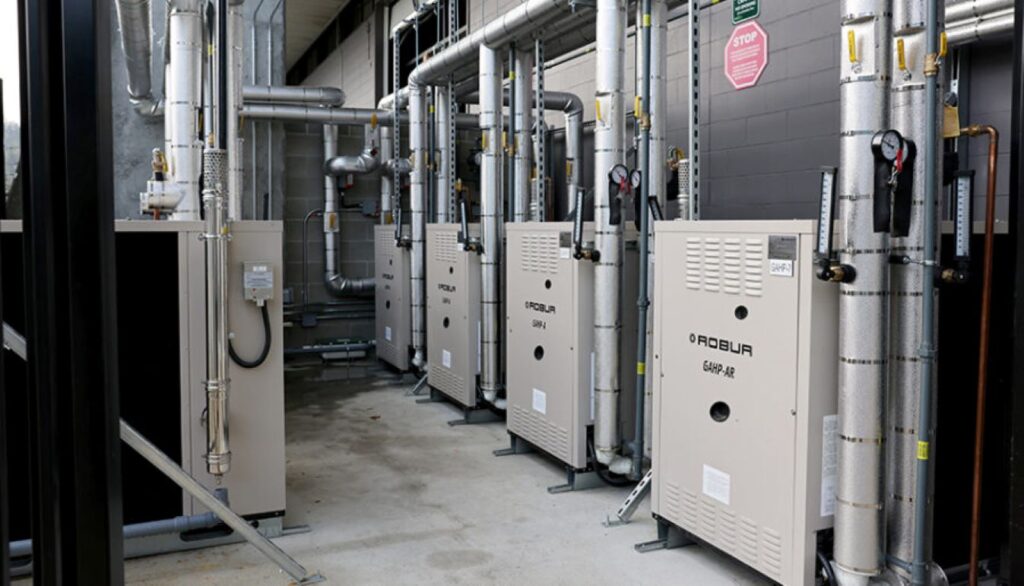6 things you need to know about gas absorption heat pumps

Similar to electric heat pumps, gas heat pumps capture heat from the outdoor ambient air and transfer it indoors for space and water heating. By transferring heat, a gas heat pump creates more than one unit of heat for every unit of energy it uses, giving gas heat pumps the ability to operate on average at more than 100 per cent efficiency.1
In 2022 we launched our commercial gas absorption heat pump rebate program—the first of its kind in Canada. Our rebate covers up to 75 per cent of the total project costs, up to $200,000, for installing eligible gas absorption heat pumps in commercial, multi-unit residential or institutional buildings.
Tried and tested technology
We’ve tested the performance of gas absorption heat pumps in commercial buildings across B.C. in a pilot program, and we’re currently testing this technology in residential homes. We surveyed past pilot participants and found out what these early adopters wish they knew sooner. Cameron Lee, a FortisBC conservation and energy management program specialist who’s focused on helping commercial and industrial customers save energy, explains some of the survey’s key findings and other learnings from the commercial gas absorption heat pump pilot.
1. Gas absorption heat pumps can maintain a comfortable space on the coldest days.
“The units are designed to operate efficiently in colder climates,” says Cameron. “They can continue to operate when temperatures drop below -40 °C, making them a great option on the coldest days, even for customers in the Southern Interior and Northern B.C.”
2. Gas absorption heat pumps can be used in a variety of applications and buildings.
Energy managers and consultants who were surveyed noted this technology is suitable for a wide range of commercial, multi-unit residential and institutional buildings, from office buildings, hotels and schools to hospitals, recreation centres, care homes and more. “The pilot demonstrated the versatility of these units, after being tested in a variety of settings,” Cameron said.
Gas absorption heat pumps can function as:
• a space heating and/or hot water system
• ventilation
• a supplementary system that can be added to improve the efficiency of existing systems
3. Gas absorption heat pumps allow customers to choose their preferred energy source.
Some customers who participated in the pilot explained that using a mix of energy sources in their operations was important for resiliency and energy security.
This technology provides an energy-efficient option to help reduce energy use, operating costs and associated GHG emissions in situations where the gas system is a customer’s preferred or most feasible energy for space and water heating.
4. Gas absorption heat pumps can reduce GHG emissions2 with fewer upgrades.
For some of our pilot participants, switching to electricity for their space or water heating isn’t an option, as there isn’t currently the capacity to accommodate it for their building or area. For others, the cost of the building upgrades needed to switch energy sources is prohibitive.
“Gas absorption heat pumps use the gas equipment that’s already available in a building, like ductwork and piping,” Cameron says. “For this reason, installing one of these high-efficiency units can be a straightforward and cost-effective option.”
5. Gas absorption heat pumps allow customers to further reduce emissions with Renewable Natural Gas.3
While some customers were more motivated by the potential cost-savings of gas absorption heat pumps, others are seeking to reduce their energy use and GHG emissions to meet targets. These units provide an opportunity for customers to designate up to 100 per cent of their energy as Renewable Natural Gas (RNG) to help lower overall emissions further.
6. Gas absorption heat pumps have actually been around for a while.
“Many customers are initially unsure about gas absorption heat pumps because of how new they are to the North American market,” Cameron says. “However, this technology has been around for the past two decades in Europe, and for the past five or so years in Asia.”
Feasibility study funding available
Curious if gas absorption heat pumps are right for your building? We offer up to $20,000 in feasibility study funding for eligible customers. Terms and conditions apply and are subject to change. Visit our website to learn more and contact your FortisBC energy solutions manager or key account manager—they can answer your questions and assist with your application.
fortisbc.com/commercialheatpump
Footnotes:
1.Coefficient of performance (COP) and gas usage efficiency (GUE) results of more than 1.0 were achieved in a Robur A gas absorption heat pump system with dynamic controls, as recorded by Building Energy Solutions (BES) Ltd. in its measurement and verification report for the gas absorption heat pump pilot, phase three and four, September 9, 2021.
2.When compared to standard-efficiency, 80 per cent annual fuel utilization efficiency, gas furnaces and boilers.
3.Renewable Natural Gas (also called RNG or biomethane) is produced in a different manner than conventional natural gas. It is derived from biogas, which is produced from decomposing organic waste from landfills, agricultural waste and wastewater from treatment facilities. The biogas is captured and cleaned to create RNG. When RNG is added to North America’s natural gas system, it mixes with conventional natural gas. This means we’re unable to direct RNG to a specific customer. But the more RNG is added to the gas system, the less conventional natural gas is needed, thereby reducing the use of fossil fuels and overall greenhouse gas emissions.
The post 6 things you need to know about gas absorption heat pumps appeared first on REMINET.

